Using Picture Talk to Support SIFE Learners
A MiddleWeb Blog
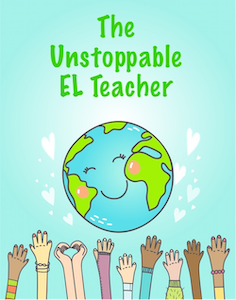 This is the 12th article in a year-long writing partnership where Valentina Gonzalez and I attempt to answer some of your questions around EL instruction. (You can find all of our articles at our blog index page.)
This is the 12th article in a year-long writing partnership where Valentina Gonzalez and I attempt to answer some of your questions around EL instruction. (You can find all of our articles at our blog index page.)
This week, I’ll share a strategy on supporting SIFE students (Students with Interrupted Formal Education) as requested by Sherry. In a future post, we’ll continue the topic of supporting SIFE students and share a second strategy.
A Personal Connection
I want to begin by sharing that I have a personal connection to this topic: My siblings were SIFE students.
In 1986 my family fled Vietnam after being persecuted for being American sympathizers. We spent 18 months in a refugee camp in the Philippines where my brothers and sister, who were older than I was, attended makeshift refugee schools. While we were grateful for these informal schools because they provided some semblance of a normal life, they could only do so much. Eventually, we were granted asylum in the United States, and my siblings navigated the American school system as SIFEs long before the term had come into popular use.
If you’d like to learn more about this part of my story, you can find it in the foreword to Carol Salva and Anna Matis’ book, Boosting Achievement: Reaching Students with Interrupted or Minimal Education (2017).
Where to start?
When we want to build a house, there are things we have to think about: siding, insulation, plumbing, electrical… the list goes on. However, no matter how we structure the rest of the elements, the house cannot stand without a strong foundation.
Similarly, working with SIFEs can be overwhelming and daunting because there are so many details to get right. There is just so much to teach: how a class works, how to get meals, going to the bathroom, recess, breaks, specials, phonics, fluency, reading, writing, and collaborating with others. This list doesn’t even include academic content work!
When building an academic house, start by laying the foundation with bricks. The foundation of a language is made of words. According to Andrea Hongisfeld and Maria Dove’s interpretation (2019) of the Features of Academic Language by WIDA (Gottlieb, 2013), they consider the bricks of a language to be the individual vocabulary words or phrases. We will address how to teach the sentence and discourse level to SIFEs in our next post on the topic.
Picture Word Inductive Model (PWIM)
Words are a low-risk point from which to launch SIFEs on their schooling journey. One of the best ways to teach words is with the Picture Word Inductive Model (PWIM) (Calhoun, 1999), which we first learned about from Larry Ferlazzo and Katie Hu Sypneiski’s book The ELL Teacher’s Toolbox (2018). PWIM is a multi-step process to directly teach the essential vocabulary of any content area or discipline. It’s also sometimes called more simply Picture Talk.
Step 1: Select an image
Find an image that contains the target vocabulary words. For example, for an ecosystem unit, you could find an image of the ecosystem you want to teach students. Dr. Katie Toppel suggests adding the words “jigsaw puzzle” to your search terms for highly detailed images.
Figure 1. Forest Community [Airbrush, Acrylic, Pencil]. Adapted from Redbubble, by L. Berlin, 2019, Retrieved from https://www.redbubble.com/people/kizmet/works/1045759-forest-community.
Step 2: Label the nouns in the image for students to see
One by one, label all the nouns in the image. Make sure to draw an arrow to the animals too. In this example, I wanted to teach students the differences between producers, primary consumers, secondary consumers, and tertiary consumers. Therefore, I identified all the producers first before going on to the other categories. As you are labeling the photo, instruct the students to repeat the words as they are said and copy them down in their own writing.
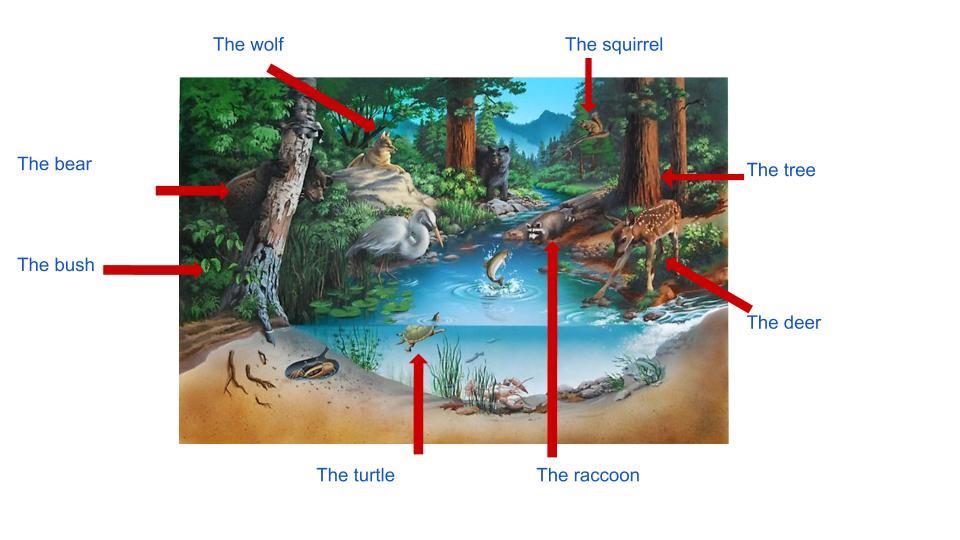
Step 3: Label the verbs
Now that students have content-specific nouns added to their vocabulary, we add the verbs. Go through each of the nouns you have labeled and write out the actions associated with each of them. Make sure to write these verbs in a different color to add visual differentiation.
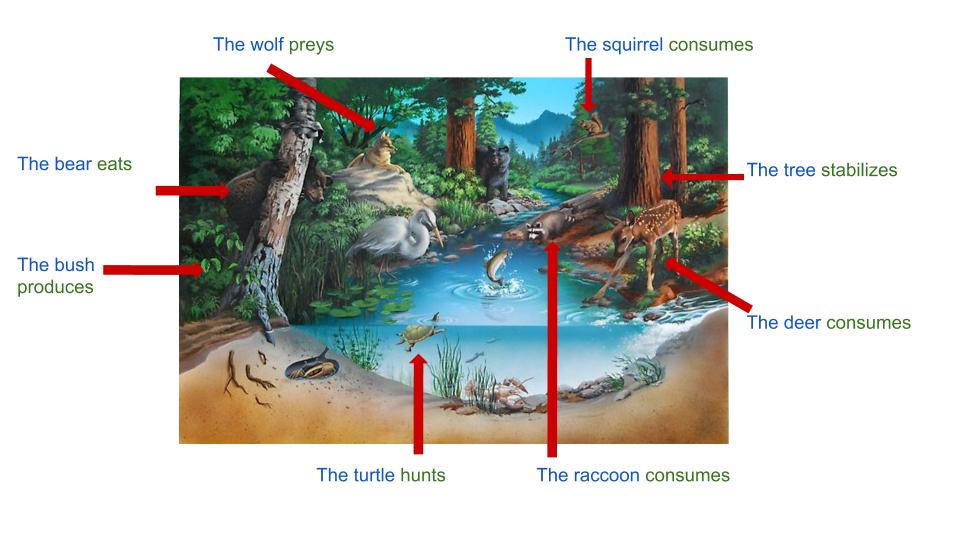
Step 4: Make a sentence
At this point, students have both nouns and verbs to explain this ecosystem. All they are missing are the details that form the predicate of the sentence. In the Trees grow example, we can add by turning sunlight into sugar. In the Wolves hunt example, we can add squirrels, which reinforces a noun students already learned in the first step.
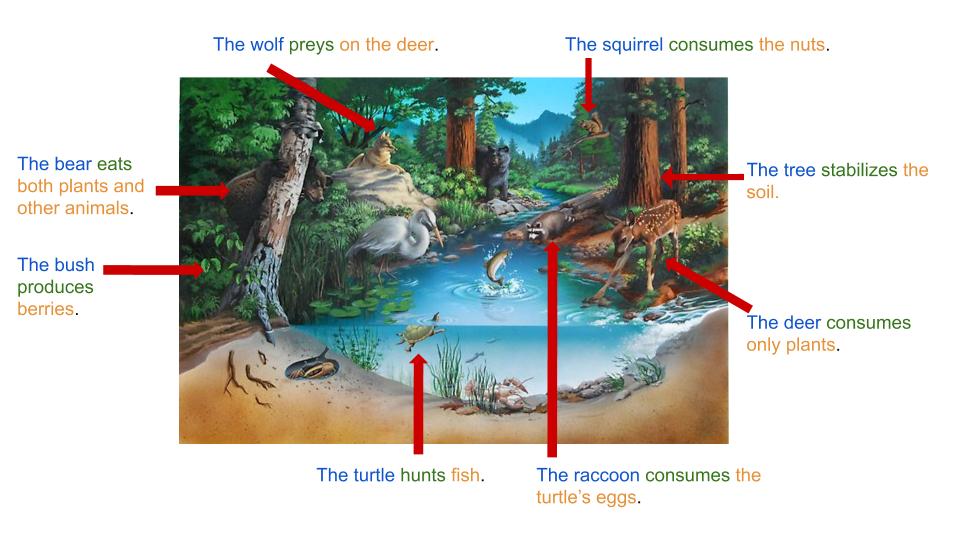
Emotionally Appropriate
Because of their developing English skills, SIFE students are often given material that’s directed at a younger audience. This can make them feel uncomfortable and discouraged. With PWIM, in contrast, SIFEs do not feel like they are receiving “baby work.” When they look around the classroom, they can visually notice that their peers are also learning the same content, just in a different way. PWIM makes it possible for teachers to teach grade-level content while still being developmentally and emotionally responsive to students.
Valentina has expertly modeled PWIM in the following video for VirtuEL17, a free online conference for teachers of ELs.
You may have astutely noticed that when we finished labeling the photo, we had many content-specific sentences that students could now read, speak, and write with some familiarity. PWIM is a strategy that embodies our go-to philosophy when working with ELs: can-do.
We can teach students
- content-specific and grade-level vocabulary
- to form simple sentences by sequencing: introducing the noun, verb, and predicate
- by labeling visuals
SIFEs can learn if we
- are planning with their emotional and developmental needs in mind
- teach content with visuals
- label diagrams
- chunk information
In the end, the strategy we use is less important than the philosophy that drives our practice. PWIM can be used effectively to teach content for teachers who possess a can-do philosophy even with students like my siblings who, because of their circumstances, were not fortunate enough to experience formal and uninterrupted education.
References
Berlin, L. (2019). Forest Community [Airbrush, Acrylic, Pencil]. Adapted from Redbubble. Retrieved from https://www.redbubble.com/people/kizmet/works/1045759-forest-community
Calhoun, E. (1999). Teaching beginning reading and writing with the Picture Word Inductive Model. Alexandria, VA: ASCD.
Ferlazzo, L., and Sypnieski, K. H. (2018). The EL teacher’s toolbox: Hundreds of practical ideas to support your students. The Teacher’s Toolbox Series. San Francisco, CA: John Wiley & Sons.
Gottlieb, M. (2013). Essential Actions: A Handbook for Implementing WIDA’s Framework for English Language Development Standards. Madison, WI: Board of Regents of the University of Wisconsin System.
Honigsfeld, A. & Dove, M. (2019, May 1). Schoolwide Best Practices to Support English Learners [Webinar]. National Professional Resources, Inc. Retrieved from https://www.youtube.com/watch?v=TholEiU9_ss&feature=youtu.be
Salva, C., and Matis, A. (2017). Boosting achievement: Reaching students with interrupted or minimal education. Irving, TX: Seidlitz Education.



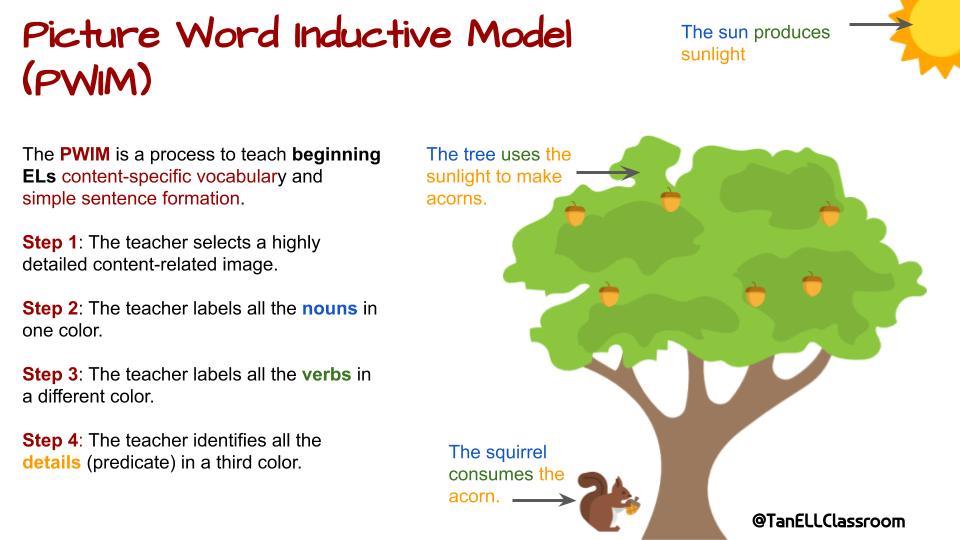

































Thanks for this article! First and foremost it reminds me to keep the rigour high!
Thank YOU, Sherry, for being the motivation behind this article!